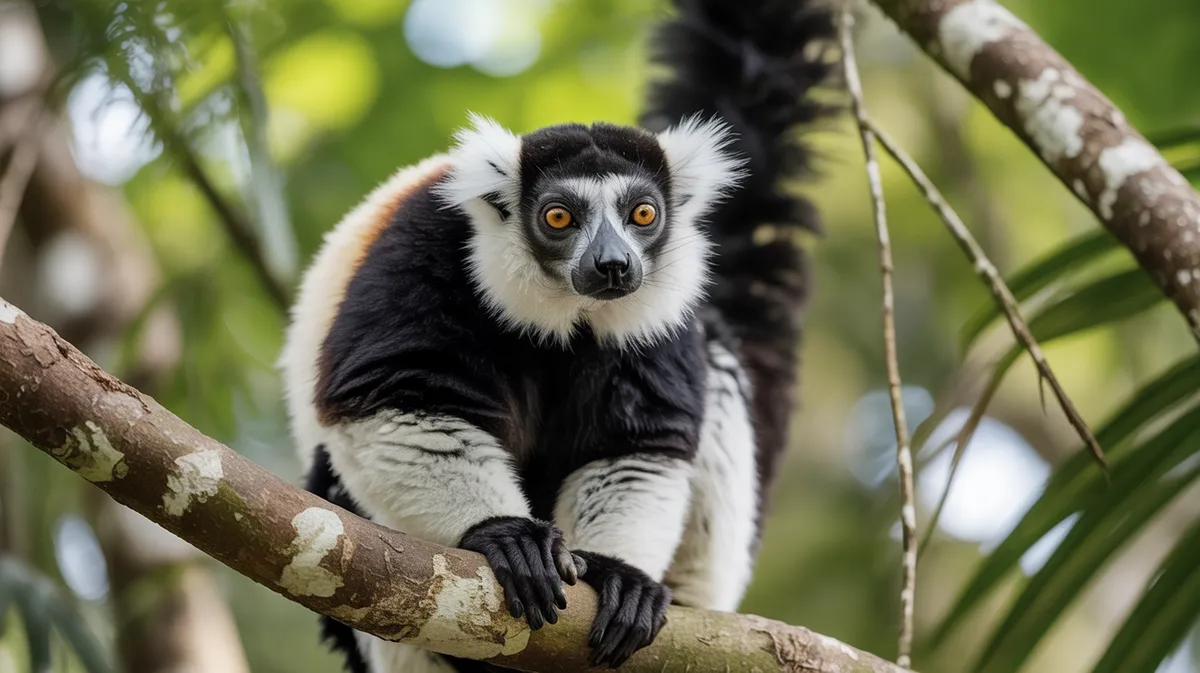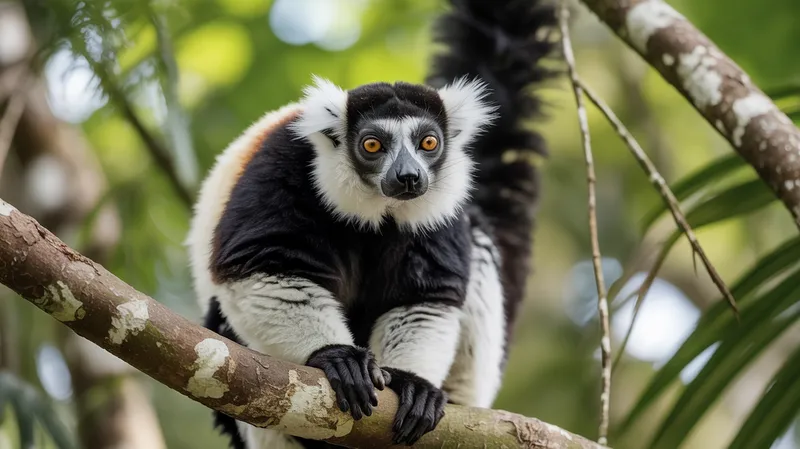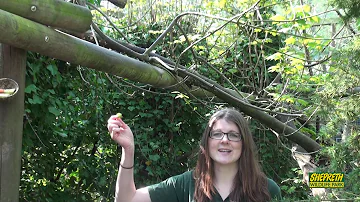
Black-and-white Ruffed Lemur
Varecia variegata

Meet the Black-and-white Ruffed Lemur
The Black-and-white Ruffed Lemur is a striking primate native to the rainforests of eastern Madagascar, known for its distinctive black and white fur pattern and luxurious ruff around its neck. This lemur is arboreal and highly agile, spending most of its life in the forest canopy, where it leaps from tree to tree in search of fruit, nectar, and pollen. Social and vocal, these lemurs live in small, matriarchal groups and are recognized for their loud, barking calls that can be heard over long distances. Due to habitat destruction and hunting, they are critically endangered in the wild.
Classification
Mammal
Habitat
Tropical rainforest canopy
Diet
Herbivore
Lifespan
15–25 years
Conservation
Critically Endangered
Weight
3–4.5 kg
📖Fascinating Facts
Canopy Dwellers
Black-and-white Ruffed Lemurs spend nearly all their lives in the upper canopy, rarely descending to the ground.
Loud Calls
Their powerful vocalizations can be heard up to a kilometer away and are used to communicate with group members and warn of danger.
Multiple Offspring
Females can give birth to as many as six infants in a single litter, one of the highest numbers among lemur species.
📋Detailed Description
The Black-and-white Ruffed Lemur (Varecia variegata) is one of the largest extant lemur species, with adults typically weighing between 3.1 and 4.1 kg and measuring 45–54 cm in body length, with a tail nearly as long as the body (50–60 cm). Its pelage is thick and soft, with sharply contrasting black and white patches that vary in pattern among the three recognized subspecies. The species is named for the prominent ruff of fur framing its face, which is especially pronounced in both sexes. Adapted for an arboreal lifestyle, it possesses strong, grasping hands and feet with opposable thumbs and toes, as well as a semi-prehensile tail that aids in balance. The face is fox-like with a long muzzle and large, forward-facing eyes adapted for binocular vision, enhancing depth perception in the dense canopy. Black-and-white ruffed lemurs are diurnal and highly vocal, producing a variety of loud calls used for group cohesion and territory defense. They are primarily frugivorous, with fruit making up over 75% of their diet, but also consume nectar, pollen, leaves, and seeds, playing a crucial role as pollinators and seed dispersers in Madagascar’s rainforests. Socially, they form fission-fusion groups that may range from 2 to 16 individuals, often centered around a dominant female. Their reproductive biology is notable for the largest litter size among primates (up to 6, but typically 2–3), and for constructing leafy nests for their altricial young, a rare trait among lemurs. The species is critically endangered, with populations fragmented and declining due to habitat loss, hunting, and low reproductive rates in the wild.
💡 Did you know?
Unlike most primates, Black-and-white Ruffed Lemur mothers build nests for their young and may leave them in the nest while foraging, a rare behavior among lemurs.
🔬Research & Sources
Wikipedia Summary
The black-and-white ruffed lemur is an endangered species of ruffed lemur, one of two which are endemic to the island of Madagascar. Despite having a larger range than the red ruffed lemur, it has a much smaller population that is spread out, living in lower population densities and reproductively isolated. It also has less coverage and protection in large national parks than the red ruffed lemur. Three subspecies of black-and-white ruffed lemur have been recognized since the red ruffed lemur was elevated to species status in 2001.
Last Modified: 5/20/2025
🎭Behavior & Social Structure
Black-and-white ruffed lemurs are primarily active during the day (diurnal), with peak activity in the early morning and late afternoon. They are highly arboreal, rarely descending to the ground, and are among the most agile leapers of all lemurs, capable of crossing gaps of up to 10 meters between trees. Their diet is dominated by fruit, especially figs and other large-seeded species, but they also feed on nectar and pollen, particularly from the traveler’s palm (Ravenala madagascariensis), using their long, dexterous tongues. Feeding is often a social activity, with individuals vocalizing to coordinate group movements. Social structure is characterized by fission-fusion dynamics, where group composition can change throughout the day, but core members (usually related females) maintain strong bonds. Territorial and group cohesion is maintained through a complex repertoire of loud calls, including barks, roars, and grunts, which can be heard over a kilometer away. Grooming is an important social behavior, facilitated by a specialized toothcomb, and helps reinforce social bonds. Rest periods are spent in the canopy, often in sun-exposed spots or in communal sleeping sites.
👶Reproduction & Life Cycle
Breeding in Black-and-white ruffed lemurs is highly seasonal, typically occurring between May and July, with births timed to coincide with the onset of the rainy season (September to October) when food is most abundant. Females are polyestrous but usually conceive only once per year. After a gestation period of approximately 90–102 days, females give birth to litters of 2–3 (occasionally up to 6) altricial infants. Unlike most lemurs, mothers construct elaborate nests 10–20 meters above ground using leaves and twigs, where the young remain for the first few weeks. Both parents, and sometimes other group members, participate in caring for the young, including carrying and guarding them. Infants are left in the nest while the mother forages, returning frequently to nurse. Weaning occurs at around 3–4 months, and juveniles become fully independent by 5–6 months. Sexual maturity is reached at about 20–24 months for females and slightly later for males.
🛡️Adaptations & Survival
The Black-and-white ruffed lemur exhibits several unique adaptations for its arboreal and frugivorous lifestyle. Its powerful hind limbs and flexible shoulder joints enable impressive leaping and brachiation through the canopy. The long, semi-prehensile tail aids in balance during rapid movement. The species possesses a specialized toothcomb (forward-projecting lower incisors and canines) used for grooming and, to a lesser extent, for scraping nectar and pollen. Their long, extensible tongues facilitate nectar feeding, making them important pollinators for several endemic plant species. The construction of arboreal nests for rearing young is a rare adaptation among primates, providing protection from predators and environmental hazards. Their loud, far-carrying calls are adaptations for maintaining contact and defending large, overlapping territories in dense forest environments.
📚Research Sources
🎨Cultural Significance
In Malagasy culture, lemurs are often regarded with a mixture of reverence and superstition. While not as prominent in folklore as some other lemur species, the Black-and-white ruffed lemur is sometimes associated with fady (taboos) that can either protect or endanger them, depending on local beliefs. Their striking appearance and loud calls have made them symbolic of Madagascar’s unique biodiversity, and they are frequently featured in ecotourism and conservation campaigns. There are no widespread traditional uses of this species, but local hunting for meat persists in some regions.
🔬Recent Research & Discoveries
Recent research has focused on the species’ role as a keystone seed disperser and pollinator, highlighting its ecological importance for forest regeneration. Genetic studies have revealed significant population structuring and low gene flow between subpopulations, emphasizing the need for habitat connectivity. Behavioral studies have documented the complexity of their vocal communication and social organization, with evidence of matriarchal dominance and cooperative breeding. Conservation research is increasingly centered on the impacts of habitat fragmentation, disease susceptibility (notably to Toxoplasma gondii), and the effectiveness of reintroduction programs. Long-term monitoring projects are ongoing in several reserves, including the Betampona and Manombo Special Reserves.
🎥Wildlife Videos

What is a Black and White Ruffed Lemur? | Fota into the Wild | Nature Bites
Black and white ruffed lemurs are incredible looking creatures with the most amazing calls and can only be found in the ...
Nature Bites

greatBIGnature / The Red Ruffed lemur
They are one of the rarest lemurs in the world. And to see one, you have to go to a small Island off the coast of Madagascar ...
Great Big Nature

Black and white ruffed lemurs
Meet the boys from Madagascar! Jen introduces us to this endangered species and tells us about their unique behaviour.
Shepreth Wildlife Park

Black-and-white ruffed lemur / Madagascar 2024
The black-and-white ruffed lemur (Varecia variegata) is a striking species of lemur native to Madagascar. Known for its bold black ...
Wildlife Israel Yuval Dax

🐒 The Black-and-White Ruffed Lemur: Madagascar’s Loudest Pollinator! 🌿
Meet the Black-and-white ruffed lemur—one of the loudest, fluffiest, and most fascinating primates on the planet! Found only ...
Amazing Planet!

Black and White Ruffed Lemur
If you love the documentary film and need some of the footage, it can be PURCHASE here under blackbox Guild. JSP is a ...
五阿哥 WuAhGe Studio Production
🌍Habitat Information
The Black-and-white Ruffed Lemur typically inhabits Tropical rainforest canopy environments. Black-and-white Ruffed Lemurs have adapted to their environments with specialized features and behaviors.
Primary Habitat:
Tropical rainforest canopy
More detailed habitat information will be available soon.
🛡️Conservation Status
The Black-and-white Ruffed Lemur is currently classified as Critically Endangered. Conservation efforts are crucial for preserving this species for future generations.
Common Threats:
- 🏠Habitat loss and fragmentation
- 🌡️Climate change impacts
- 🎯Hunting and poaching
- 🏭Human-wildlife conflict
⚠️Threats & Conservation Challenges
The primary threats to Black-and-white ruffed lemurs are habitat destruction from slash-and-burn agriculture (tavy), illegal logging, and mining, which have resulted in severe fragmentation of their eastern Madagascar rainforest habitat. Hunting for bushmeat and capture for the illegal pet trade further exacerbate population declines. The species is particularly vulnerable due to its low reproductive rate, large home range requirements, and sensitivity to habitat disturbance. Population estimates suggest fewer than 10,000 mature individuals remain, distributed in small, isolated subpopulations, many of which are not within protected areas. Climate change poses additional risks by altering fruiting patterns and increasing cyclone frequency, which can devastate local populations. Conservation challenges include enforcing existing protections, expanding habitat corridors, and implementing community-based conservation initiatives.
🔬Scientific Classification
Scientific Name
Varecia variegata
Classification Hierarchy
🔍 About Taxonomic Classification
Taxonomic classification is a hierarchical system used by scientists to classify and organize living organisms based on shared characteristics and evolutionary relationships.
The system moves from broad categories (Kingdom) to increasingly specific ones, with each animal's scientific name typically consisting of its Genus and species.
📝Community Notes
Share your observations and insights about the Black-and-white Ruffed Lemur with our community of wildlife enthusiasts.
Join Our Community
Sign in to share your observations and connect with fellow wildlife enthusiasts.
Sign In to ContributeNo community notes yet
Be the first to share your observations about the Black-and-white Ruffed Lemur!
Explore Black-and-white Ruffed Lemur
Select a tab above to learn more about this amazing animal.
📸Photo Gallery
No photos available for this animal yet.
🌟Discover More Wildlife
Continue your journey of discovery with more fascinating animals from our database
